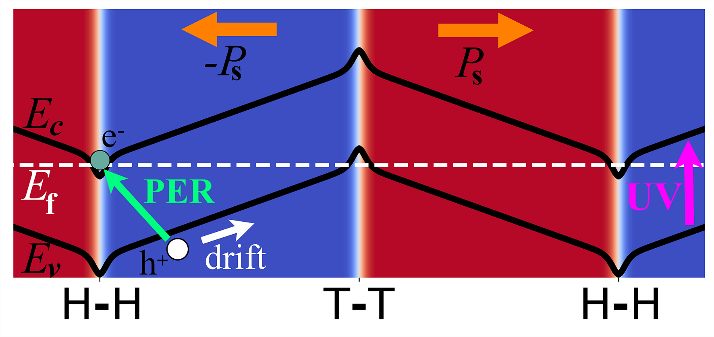Jonathan Ordóñez Pimentel defends his thesis on light-matter coupling in ferroelectric materials
Mar 28, 2023
Jonathan Ordóñez defended his thesis coadvised by Jose Eduardo García and Michel Venet on the 24th of March in Campus Nord. Entitled "Theoretical and experimental investigation on the visible-light controlled functional properties in charged domain wall ferroelectrics", the thesis focuses in overcome some questions that remained to be solved concerning light-activated phenomena in ferroelectric materials.
Optical control of ferroelectric properties has been attracted a growing interest as an alternative to the conventional control by applied electric fields. However, the major drawback for achieving an effective reversible optical control of domain rearrangement in conventional ferroelectrics lies in their wide optical band gap. Recent researches has reported a new form to optically control of electric polarization and its related properties by using visible light. Specifically, a light-induced local movement of domain walls was achieved, whose effects shown that the photoresponse at both local and macroscopic scales is wavelength-independent. This new phenomenon of light-matter coupling has a non-negligible time response and no light power threshold was observed. Such characteristics are observed through the crystal lattice structure, photo-induced strain and dielectric permittivity. In addition, experimental evidences suggest that the light-activated phenomenon seems to be correlated with the existence of atypical ferroelectric interfaces, known as charged domain walls, whose principal signature is to host free and bound electric charge. Undoubtedly, this phenomenon offers new possibilities for technological applications that are as yet unexplored.
This thesis focuses in overcome some questions that remains to be solved concerning to this light-activated phenomenon. That is: What is the physical insight about the photo-ferroelectric response? Is the extension towards polycrystalline materials feasible? Are there other physical properties different from those already controlled enable to be modified? To answer these question, the thesis divides into two parts: one theoretical and another one experimental. In the first part, a phenomenology model describing the visible light-induced photoresponse is developed, which assumes that visible light modifies charged domain wall compensation so that the built-in electric fields in the system changes, thereby triggering the domain wall motion. As a result, a rearrangement of the domain structure occurs, leading to a macroscopic polarization variation and, consequently, the related properties. Regarding to extension towards polycrystalline materials, it is successfully proved that photoresponse can be observed by the optical control of the photo-induced strain. Furthermore, it is proved the hypothesis that the existence of charged domain walls is a requirement for the photoresponse to manifest. Finally, the thesis reports for first time that the mechanical response of a ferrolectric ceramics can be modulated by visible light, highlighting the role of the charged domain walls.
In a broader perspective, this work contributes to extending the fundamental knowledge based on light-ferroelectric coupling, opening new opportunities to speed up the development of a new generation of contact-less photoelectronic devices.

Share: